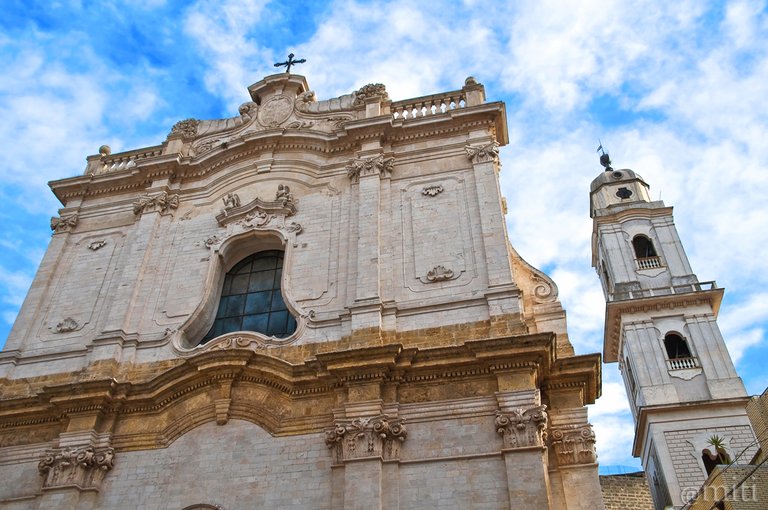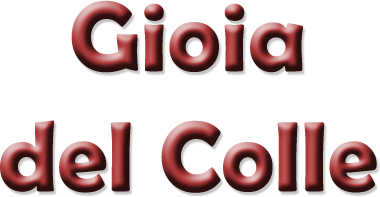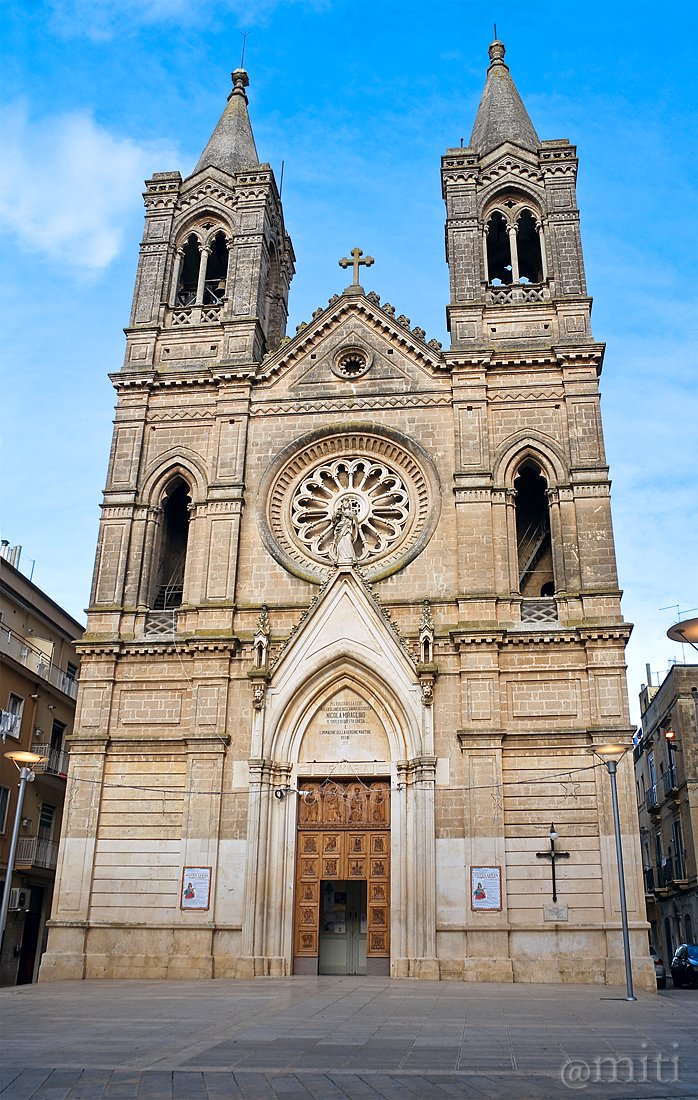
The Mother Church of St. Maria Maggiore (Author's photo - All rights reserved)
La Chiesa Madre di S. Maria Maggiore (Immagine dell'autore - tutti i diritti sono riservati)



Ciao a tutti,
questo è un viaggio attraverso l'Italia. Posterò una foto al giorno con una brevissima descrizione. Spero vi piaccia!

Gioia del Colle è una città in provincia di Bari, nella regione meridionale italiana della Puglia. E 'strategicamente posizionato a metà strada tra il Mar Ionio e il Mar Adriatico ad est e ad ovest, e tra le città di Bari e Taranto a nord e sud.
Anche se il territorio risulta abitato sin dalle epoche neolitica e messapica, come confermato dall'esistenza di un centro Peucezio sul Monte Sannace del VII secolo aC, l'abitato di oggi è stato ricavato da un antico forte costruito durante l'epoca bizantina (VI secolo), nel luogo dell'attuale borgo di S. Nicola.
Il suo nome deriva forse da Joha, abbreviazione di un cognome della famiglia bizantina presente in questi luoghi in epoca medievale. Ma ci sono molte opinioni sull'origine dello stesso, compresa la leggenda che vede come protagonista la Principessa Bianca Lancia che, prima di essere rinchiusa da Federico che l'aveva sospettata di infedeltà, ha perso tutti i suoi gioielli nel castello e non li ha mai più ritrovati : Gioia del Colle avrebbe indicato i gioielli della donna sparsi per la collina.
Divenne poi una roccaforte normanna durante l'11 ° secolo, che vide la ricostruzione del suo castello sotto Riccardo Siniscalco d'Altavilla, e successivamente gli Svevi (1194-1268), che ricostruirono il castello precedentemente distrutto dal normanno Guglielmo I il Malo.
Conquistata dagli Angioini nella seconda metà del XIII secolo Gioia divenne parte del principato di Taranto, poi della Contea degli Acquaviva d'Aragona e dei principi De Mari.
Punto di partenza di una visita a Gioia del Colle è sicuramente il castello normanno-svevo, uno dei più belli e ben conservati della regione. Il Castello ospita il Museo Archeologico Nazionale che espone reperti di reperti provenienti dalla vicina area archeologica del Monte Sannace.
Per completare la visita al borgo, punti d'interesse saranno la Casa Torre (XV secolo), l'Arco di Nardulli (XIII secolo) e l'Arco di Cimone.
Tra le chiese da visitare, la Normanna, ma con l'attuale aspetto barocco, Chiesa di S. Angelo (o S. Maria di Costantinopoli) e la Chiesa Madre o di S. Maria Maggiore (XII secolo, più tardi ricostruita nel XVIII secolo), S. Antonio (XVII secolo), che conserva un crocifisso ligneo e una serie di affreschi.
A pochi chilometri dalla città, è possibile visitare il Parco Archeologico del Monte Sannace.
Cosa vedere: il Centro Storico, il Castello Normanno-Svevo, il Parco Archeologico del Monte Sannace, il Museo Archeologico Nazionale, la Casa Torre, l'Arco Nardulli, l'arco Cimone, la chiesa di S. Angelo , la Chiesa Madre si S. Maria Maggiore, la Chiesa di S. Antonio, la Chiesa di S. Lucia.

Hello everyone,
I began a Photo Journey through Italy. I will post one photo every day with a little note of explanation. I hope you like it!

Gioia del Colle is a town in the province of Bari, in the southern Italian region of Puglia. It's strategically located half way between the Ionian and Adriatic seas to the east and west, and between the cities of Bari and Taranto to the north and south.
Even though the territory results as inhabited since Neolithic and Messapian eras, as confirmed by the existence of a Peucezio centre in Monte Sannace from the 7th Century BC, today’s habitation was developed from an ancient fort constructed during the Byzantine era (6th Century), on the spot which is the present day suburb of S. Nicola.
Its name derives perhaps from Joha, short for a Byzantine family surname present in these places in the medieval age. But there are many opinions on the origin of the name, including the legend that sees as protagonist the Princess Bianca Lancia who, before being locked up by Frederick who had suspected her of infidelity, lost all her jewels in the castle and never found them again: Gioia del Colle would indicate the jewels of the woman spread around the hill.
It then became a Norman stronghold during the 11th century, which saw the reconstruction of its castle under Riccardo Siniscalco d’Altavilla, and later the Swabians (1194-1268), who reconstructed the castle previously destroyed by the Norman Guglielmo I the Malo.
Conquered by the Angioini during the second half of the 13th Century, Gioia became part of the Principality of Taranto, then the Earldom of the Acquaviva of Aragona Family and later of the Princes De Mari.
The main highlight of a visit to Gioia del Colle is definitely the Norman-Swabian Castle, one of the most beautiful and well preserved in the region. The Castle hosts the National Archaeological Museum which exhibits remains of finds from the nearby archaeological area of Monte Sannace.
To complete the visit to the suburb, interesting stops would be: the Casa Torre (15th Century), Nardulli Arch (13th Century) and the Cimone Arch.
Among the churches to visit, the Norman, with a present day Baroque look Church of S. Angelo (or S. Maria of Constantinople) and the Mother Church or S. Maria Maggiore (12th Century, later reconstructed during the 18th Century), S. Antonio (17th Century), which preserves a wooden crucifix and a series of frescoes.
A few kilometres from the city, it is possible to visit the Archaeological Park of Mount Sannace.
Thing to see: the Historical centre, the Norman-Swabian Castle, the Archaeological Park of Mount Sannace, the National Archaeological Museum, the Casa Torre, the Nardulli Arch, the Cimone Arch, the Church of S. Angelo, the Mother Church of S. Maria Maggiore, the Church of S. Antonio, the Church of S. Lucia.

| Tipo di foto / Category | Paesaggio / Landscape view |
| Esposizione / Settings | 1/125 sec, ISO 200, f/9 |
| Camera | Nikon D5000 |
| Lente / Lens | Tamron SP 17-50mm f/2.8 XR Di II LD |
| Filtro / Filter | Polarizzatore Hoya / Hoya Polarizing filter |
| Cavalletto / Tripod | Manfrotto MKC3-P01 |
| Località / Location | Gioia del Colle (Bari), Italia |
| Software | Photoshop |


The Church of S. Lucia (Author's photo - All rights reserved)
La Chiesa di Santa Lucia (Immagine dell'autore - tutti i diritti sono riservati)
wonderful.
Che bella questa chiesa!
Incredibile pensare che l'abbiano costruita con tecnologie lontanissime da quelle di oggi!
Good work, nice photo and good blog!! Thanks for sharing. Followed and upvoted.
Thanks!
Very beautiful picture
nice!
Wonderful photography. Love your photography work. Very good job my dear friend miti
A beautiful religious place
Yes, it is!
Very beautiful picture
Posted using Partiko Android
Beautiful image, I really like that type of church.
Yeah, it's very beautiful.
bella foto
Grazie ;-)
@miti can the hindu go to this church ?
Our churches are open to all.
Beautifull picture, the photoshop manipulation is not overdone.
Yes, it's a thing which I try to keep to a minimum.
This is beautiful!
great click
I do not speak Italian but I love the idea of traveling through pictures, keep them coming!
It's a bilingual post..
Beautiful photos, Amazing
You got a 59.11% upvote from @ocdb courtesy of @miti!
Nice content. Follow me also. Upvote, Comment, and Resteem. Let's build big connections.
Your comment is considered SPAM... Take a look in this guide:
https://steemit.com/steemit/@miti/a-complete-guide-for-newcomers-and-minnows-to-avoid-a-possible-spam-and-to-write-good-comments
It will help you.
@miti Thank you for your advice!
wonderful pictures , brother give some tips to me if possible.
Your comment is considered SPAM... Take a look in this guide:
https://steemit.com/steemit/@miti/a-complete-guide-for-newcomers-and-minnows-to-avoid-a-possible-spam-and-to-write-good-comments
It will help you.